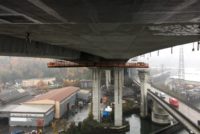Nearly eight months after the emergency closure of the West Seattle Bridge, Seattle Mayor Jenny Durkan announced Nov. 19 a decision to repair, not replace, the cracked span over the Duwamish River, aiming to have traffic flowing on the bridge again in 2022.
A replacement of the span would have pushed the finished timeline to 2025 or 2026.
Design consultant HNTB will continue to move forward with a type, size and location study to lay the groundwork for future bridge replacement. In August, Seattle tapped an HNTB-led team to design a long-term replacement for the 2,607-ft long structure. HNTB was not immediately available for comment.
“We will move forward with repairing the West Seattle Bridge to restore mobility as soon as possible,” Durkan said in an announcement. “This corridor is critical to our economy and our residents and the other options could not realistically be done in a reasonable timeframe, would cost significantly more money and provided no more capacity for transit or other modalities.”
Durkan says that while all options have risks, a repair will get West Seattle reconnected the fastest. She says funding is also more certain for a repair.
The Seattle Dept. of Transportation closed the high-rise bridge in March due to cracks. Since then Kraemer North America, hired under an emergency contract to stabilize the structure, has injected epoxy into cracks, added external post-tensioning to support the existing internal post-tensioning system and released the damaged bearing at Pier 18.
To wrap up Phase I repair work on the bridge, crews will replace the lateral bearing on the east end of the bridge that allows the bridge to expand and contract with temperature and loading changes and finish wrapping girders in carbon fiber to offer additional strength. WSP is providing the engineering.
Kraemer and WSP did not immediately respond to requests for comment.
“The mayor’s decision to repair the West Seattle High-Rise Bridge continues work that has been happening on, under and inside the bridge since March,” said Sam Zimbabwe, city DOT (SDOT) director, in a statement. “Through these ongoing stabilization repairs, we are already months down this pathway.”
Part II of the repair work will look similar to Phase I, featuring post-tensioning on additional bridge spans. Plans also call for the review of the seismic condition of the Pier 18 foundation and completing a study that models repair needs on other parts of the bridge.
Phase I should wrap up in 2020 and WSP engineers will monitor the bridge’s movements over the winter months while forming a Phase II plan, likely starting that work in spring 2021. SDOT says that to complete Phase II planning, WSP needs to observe a winter thermal cycle to see how the newly installed stabilization measures respond to cold weather, especially sub-freezing temperatures.
SDOT says any future replacement gives the city certainty about the best solution and one that takes full advantage of opportunities for improved mobility.
Durkan worked with SDOT’s structural team and technical advisory panel composed of field experts, as well as a community task force, to reach her decision.
The agency expects to have a timeline for repair activities by the end of 2020 and a cost estimate and design in early 2021.





